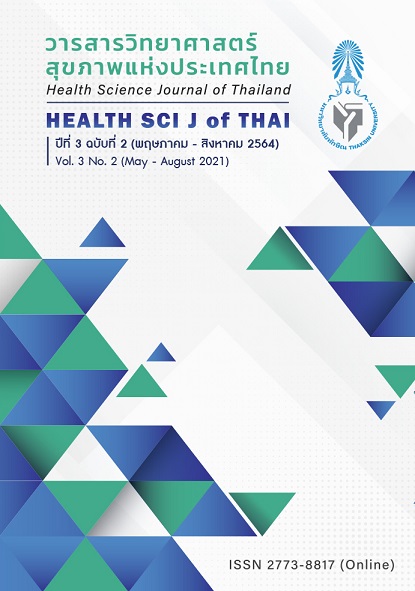Correlation between Antimicrobial Resistance and Antimicrobial Consumption in Krabi Hospital
Main Article Content
Abstract
Antimicrobial resistance become a current threat worldwide. The objective of this cross-sectional study was to examine the trend of antimicrobial resistance, and correlation of antimicrobial consumption and antimicrobial resistance in Krabi Hospital. The results of antimicrobial susceptibility and antimicrobial consumption were measured by daily defined dose during 2013-2019. The proportion of bacterial isolates-resist to antimicrobials and correlation of antimicrobial consumption were analyzed. The results showed that Pseudomonas aeruginosa retaining sensitivity to Amikacin with a statistically significant increased, the percent of resistant isolates was decreased (p-value = 0.042). Escherichia coli resistant to Piperacillin and Ertapennem decreased less than 10 folds, resistant to isolates to Piperacillin from 0.66% to 8.57% (p-value = 0.004), reistant to Ertapenem increased from 0.19% to 7.38% (p-value = 0.030). An antimicrobial consumption of Amikacin, Cefotaxime and Norfloxacin was statistically decreasesd (p-value = 0.027, 0.006, and 0.037). An increasing trends of using Ceftazidime, Piperacilin/Tazobactam, and Ertapenem was showed (p-value = 0.018, 0.006 and 0.030). Escherichia coli showed a positive correlation between drug consumption and resistant to Meropenem and Piperacilin/Tazobactam (r = 0.96, p-value <0.001, and r = 0.79, p-value =0.036).
Article Details

This work is licensed under a Creative Commons Attribution-NonCommercial-NoDerivatives 4.0 International License.
References
Chanvatik, S. Surveillance of antimicrobial consumption in Thailand: A foundation for controlling antimicrobial resistance. HSRI Journal 2017; 11(5): 593-607. (in Thai).
The national strategic plan on antimicrobial resistance 2017-2021 Thailand [Internet]. c2016 [cited 2017 Dec 10]. Available from: http://narst.dmsc.moph.go.th/documentation/AMR%20strategy%202560-2564.pdf. (in Thai)
Antimicrobial resistance. Antimicrobial resistance-tackling a crisis for the health and wealth of nations [Internet]. 2014 [cited 2017 Dec 10]. Available from: https://amr-review.org/sites/default/files/AMR%20Review%20Paper%20%20Tackling%20a%20crisis%20for%20the%20health%20and%20wealth%20of%20nations_1.pdf.
Olusoji, O.A., Enis, B., Olga, B.J., Alec, I., Berthe, FCJ., Francois, L.G., et al. Drug-resistant infections a threat to our economic future. Executive summary. Washington: International Bank for Reconstruction and Development/the World Bank; 2017 Oct. Report No.: 114679.
United Nations meeting on antimicrobial resistance [Internet]. Bull World Health Organ; 2016 [cited 2017 Dec 10]. Available from: http://www.who.int/bulletin/volumes/94/9/16-020916.pdf/ doi:10.2471/ BLT.16.020916.
Holmes, A.H., Moore, L.S.P., Sundsfjord, A, Steinbakk, M., Regmi, S., Karkey, A., et al. Understanding the mechanisms and drivers of antimicrobial resistance. Lancet. 2016; 387: 176–87.
Grigoryan, L., Burgerhof, J.G.M, Degener, J.E., Deschepper, R., Lundborg, C.S., Monnet, D.L, et al. Determinants of self-medication with antibiotics in Europe: the impact of beliefs, country wealth and the healthcare system. Antimicrob Chemother. 2008; 61(5): 1172–9.
Hunter, P.A., Dawson, S., French, G.L., Goossens, H., Hawkey, P.M., Kuijper, E.J., et al. Antimicrobial-resistant pathogens in animals and man: prescribing, practices and policies. J Antimicrob Chemother. 2010; 65 Suppl 2: I3–17.
Huttner, B., Goossens, H., Verheij, T., & Harbarth, S. Characteristics and outcomes of public campaigns aimed at improving the use of antibiotics in outpatients in high-income countries. Lancet Infect Dis. 2010; 10(1): 17–31.
Plachouras, D., Kavatha, D., Antoniadou, A., Giannitsioti, E., Poulakou, G., Kanellakopoulou, K., et al. Dispensing of antibiotics without prescription in Greece, 2008: another link in the antibiotic resistance chain. Euro surveillance. 2010; 15 (7): 4–7.
Goossens, H., Ferech, M., Vander, S.R., & Elseviers, M. Outpatient antibiotic use in Europe and association with resistance: a cross-national database study. Lancet. 2005; 365: 579–87.
World Health Organization. Global action plan on antimicrobial resistance. World Health Organization [Internet]. 2015. [cited 2018 Aug 24]. Available from: http://www.pro.who.int/entity/drug_resistance/resources/global_action_plan_eng.pdf.
World Health Organization. Evaluation of antibiotic awareness campaigns [Internet]. Report 2016. Geneva: Expert Committee on the selection and use of essential medicines policy, access and use (PAU); 2016. [cited 2018 Apr 1]. Available from: http://www.who.int/selection_medicines/committees/expert/21/applications/s6_antibiotic_ awareness_campaigns.pdf.
Chaintarli, K., Ingle, S.M., Bhattacharya, A., Ashiru-Oredope, D., Oliver, I., & Gobin, M. Impact of a United Kingdom-wide campaign to tackle antimicrobial resistance on self-reported. 2019.
Chaiyasong, C., Tayapak, P., Pinake, S., & Chaiyasong, S. Associations between antibiotic use and resistance in Mahasarakham Hospital. IJPS. 2019;15(2). 98-105.


